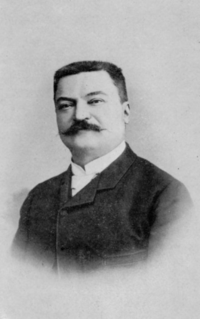Édouard Lucas: Difference between revisions
m →Biography: "Elementary proofs" wikified |
|||
| Line 42: | Line 42: | ||
He worked on the development of the [[umbral calculus]]. |
He worked on the development of the [[umbral calculus]]. |
||
Lucas was also interested in [[recreational mathematics]]. He found an elegant [[Binary numeral system|binary]] solution to the [[Baguenaudier]] puzzle. He more notably invented the [[Tower of Hanoi]] puzzle, which he marketed under the nickname ''N. Claus de Siam'', an [[anagram]] of ''Lucas d'Amiens'', and published for the first time a description of the [[Dots and Boxes]] game in 1889. |
Lucas was also interested in [[recreational mathematics]]. He found an elegant [[Binary numeral system|binary]] solution to the [[Baguenaudier]] puzzle. He more notably invented the [[Tower of Hanoi]] puzzle, which he marketed under the nickname ''N. Claus de Siam'', an [[anagram]] of ''Lucas d'Amiens'', and published for the first time a description of the [[Dots and Boxes]] game in 1889. Such other accomplishments pale in comparison to the joy he has bestowed upon thousands and thousands of children (and bored work employees) through the game of "Dots and Boxes" |
||
Lucas died in unusual circumstances. At the banquet of the annual congress of the ''Association française pour l'avancement des sciences'' a waiter dropped some crockery and a piece of broken plate cut Lucas on the cheek. He died a few days later of a severe skin inflammation probably caused by [[septicemia]]. Lucas was only 49 years old when he died. |
Lucas died in unusual circumstances. At the banquet of the annual congress of the ''Association française pour l'avancement des sciences'' a waiter dropped some crockery and a piece of broken plate cut Lucas on the cheek. He died a few days later of a severe skin inflammation probably caused by [[septicemia]]. Lucas was only 49 years old when he died. |
||
Revision as of 20:52, 8 November 2010
Édouard Lucas | |
|---|---|
 | |
| Born | 4 April 1842 |
| Died | 3 October 1891 (aged 49) |
| Nationality | |
| Alma mater | École Normale Supérieure |
| Known for | Lucas sequence, Lucas-Lehmer test, Lucas prime, Gauss-Lucas theorem, Lucas' theorem |
| Scientific career | |
| Fields | Mathematics |
François Édouard Anatole Lucas (4 April 1842 – 3 October 1891) was a French mathematician. Lucas is known for his study of the Fibonacci sequence for which he gave a formula[which?] for finding the nth term. The related Lucas sequences and Lucas numbers are named after him.
Biography
Lucas was educated at the École Normale Supérieure. He worked in the Paris observatory and later became a professor of mathematics in Paris. In the meantime he served in the army.
In 1875, Lucas posed a challenge to prove that the only solution of the Diophantine equation:
with N > 1 is when N = 24 and M = 70. This is known as the cannonball problem, since it can be visualized as the problem of taking a square arrangement of cannonballs on the ground and building a square pyramid out of them. It was not until 1918 that a proof (using hyperelliptic functions) was found for this remarkable fact, which has relevance to the bosonic string theory in 26 dimensions.[1] Elementary proofs have been more recently published.[2][3]
He devised methods for testing the primality of numbers. In 1857, at age 15, Lucas began testing the primality of 2127 − 1 by hand, using Lucas Sequences. In 1876, after 19 years of testing,[4] he finally proved that 2127 − 1 was prime; this would remain the largest known Mersenne prime for three-quarters of a century. This may stand forever as the largest prime number proven by hand. Later Derrick Henry Lehmer refined Lucas' primality tests and obtained the Lucas-Lehmer test.
He worked on the development of the umbral calculus.
Lucas was also interested in recreational mathematics. He found an elegant binary solution to the Baguenaudier puzzle. He more notably invented the Tower of Hanoi puzzle, which he marketed under the nickname N. Claus de Siam, an anagram of Lucas d'Amiens, and published for the first time a description of the Dots and Boxes game in 1889. Such other accomplishments pale in comparison to the joy he has bestowed upon thousands and thousands of children (and bored work employees) through the game of "Dots and Boxes"
Lucas died in unusual circumstances. At the banquet of the annual congress of the Association française pour l'avancement des sciences a waiter dropped some crockery and a piece of broken plate cut Lucas on the cheek. He died a few days later of a severe skin inflammation probably caused by septicemia. Lucas was only 49 years old when he died.
Works
- Recherches Sur Plusieurs Ouvrages De Léonard De Pise Et Sur Diverses Questions D’Arithmétique Supérieure (1877)
- Théorie des nombres, Tome Premier (1891)
- Récréations mathématiques (1894)
- L'arithmétique amusante (1895)
See also
References
- ^ http://math.ucr.edu/home/baez/week95.html
- ^ Ma, D. G. (1985). "An Elementary Proof of the Solutions to the Diophantine Equation ". Sichuan Daxue Xuebao. 4: 107–116.
- ^ Anglin, W. S. (1990). "The Square Pyramid Puzzle". American Mathematical Monthly. 97 (2): 120–124. doi:10.2307/2323911.
- ^ http://primes.utm.edu/curios/page.php?number_id=135
- Weisstein, Eric W. "Cannonball Problem". MathWorld.
- Williams, Hugh C. (1998). Édouard Lucas and primality testing. Canadian Mathematical Society series of monographs and advanced texts. Vol. 22. New York: Wiley. ISBN 0471148520Template:Inconsistent citations
{{cite book}}: CS1 maint: postscript (link).


